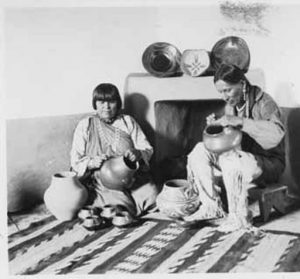
San Ildefonso Potters Maria and Julian Martinez Photograph Courtesy of the Palace of the Governors Photo Archive
Maria Martinez is considered one of the most famous of all the pueblo potters. She learned to make pottery from her aunt Nicolasa. By the age of thirteen Maria had acquired exceptional skill in making pottery. She married her husband Julian in 1904, he was an acknowledged painter. They spent their honeymoon demonstrating pottery at the World’s Fair in St. Louis, this was the first of many exhibitions they attended.
In 1907 Julian was hired by Dr. Edgar Hewett the Director of the School of American Research in Santa Fe, NM to help with an archaeological excavation on the Pajarito Plateau. Dr. Hewett encouraged Maria to make replicas of the old polychrome pots that were found. The painted designs were in black and orange on a cream slip. Julian spent a lot of time searching for new design ideas by studying ancient pottery collections at the Museum of New Mexico. He was a great innovator and experimented with new paints, clays, and techniques. His experiments led him to the invention of the now famous matte-black-on-polished-black pottery. By 1921 Julian had perfected the process and the black-on-black pottery became extremely popular. Julian’s Avanyu (water serpent) and feather designs were also very popular (Schaaff, 2000).
Maria and Julian discovered how to make the now famous black-on-black pottery in 1918. Maria skillfully made the pots and Julian did the painting and design. Their work was shown at exhibitions and World Fairs. At the 1925 New York World’s Fair they won Best of Show and eight years later won again the Best of Show, this time at the Chicago World’s Fair. Together Maria and Julian were key figures in leading a pottery and cultural heritage revival, not only in their pueblo of San Ildefonso but as well as other pueblos (Schaaff 2000).
Their four sons were also taught the art of pottery making. After Julian’s death in 1943 Maria began working with her daughter-in-law Santana. It was after 1956 that she worked with her son Popovi Da. Signatures on Maria’s pottery vary depending on who she was working with at the time. Pieces made by Maria and Julian from 1918 to 1923 are unsigned. By 1923 Maria began signing her name “Marie.” From 1925 until Julian’s death the signature on their pots was “Marie + Julian. Pottery made from 1943-1954 are signed “Marie + Santana or Maria + Santana.” When her son began working with his mother 1923-1971 they would cosign the pieces “Maria/Popovi.” In 1959 Popovi had an idea of adding the month and the year of firing to the pots along with the signature. The reason for this was to distinguish authentic Maria pieces from others who had signed her name. Maria also made smaller pieces on her own, which were always plain, polished, undecorated pieces, but were well made; these pieces were signed “Maria Poveka” (Spivey, 1989).
BIBLIOGRAPHY
Scaaf, Gregory. Pueblo Indian Pottery: 750 Artist Biographies. Santa F, NM: CIAC Press. 2000.
Spivey, Richard L. Maria. 2nd Edition. Flagstaff, AZ: Northland Press. 1989.
